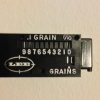rcmodel
Member in memoriam
SO, I played around with the PIF Lee scale I received from Boltlover yesterday evening, and today.
I tested it against an old Cabala’s (PACT) Digital, and my old RCBS 5-10 beam scale.
Results, were ‘interesting’.
Here was the 'level both ways' set-up.
(Each scale was set on the Level top surface & Zeroed before each test.)

Here are the results.

Here is the ‘interesting part.
While weighing a 50 grain Hornady V-Max, I got this reading.
Which could be telling me 50.0, or 50.85??
It was the only instance I ran into that could be interpreted so obviously nearly a grain wrong!

SO what is my verdict?
Pro:
*Low cost.
*Accurate enough for reloading use.
*Repeatable, once you get it set and lock down the 1/10 grain poise.
Cons?
*Very hard to read the Vernier settings with old eyes.
*Yes, I have been reading vernier calipers my whole life. (Just not this one!)
*A simple V-groove and sliding weight like other less expensive scales would be way more user friendly for me to use.
*Grain Poise is way too easy to move if not locked in place. (or impossible to move if locked in place)
*Beam rubs on base way too easily and screws up reading if you wiggle or bump it whain changing pans.
*The scale is so light it is easily moved when trying to make adjustments or zero it.
*Very slow & sensitive when weighing unknown weights. (Too fiddly for me!)
*Not enough capacity to weigh most bullets larger than .224” and .243”.
*Weighing .30 cal rifle and pistol bullets is impossible.
Bottom Line:
Both the digital and the RCBS are much faster to set up, zero, and weigh unknown charge weights with.
I trust the RCBS further then the Digital!
I would trust the Lee further then the Digital too, if I was 100% sure of the vernier setting..
I could make do with it if that’s what I had.
But that isn't what I have.
rc
I tested it against an old Cabala’s (PACT) Digital, and my old RCBS 5-10 beam scale.
Results, were ‘interesting’.
Here was the 'level both ways' set-up.
(Each scale was set on the Level top surface & Zeroed before each test.)

Here are the results.

Here is the ‘interesting part.
While weighing a 50 grain Hornady V-Max, I got this reading.
Which could be telling me 50.0, or 50.85??
It was the only instance I ran into that could be interpreted so obviously nearly a grain wrong!

SO what is my verdict?
Pro:
*Low cost.
*Accurate enough for reloading use.
*Repeatable, once you get it set and lock down the 1/10 grain poise.
Cons?
*Very hard to read the Vernier settings with old eyes.
*Yes, I have been reading vernier calipers my whole life. (Just not this one!)
*A simple V-groove and sliding weight like other less expensive scales would be way more user friendly for me to use.
*Grain Poise is way too easy to move if not locked in place. (or impossible to move if locked in place)
*Beam rubs on base way too easily and screws up reading if you wiggle or bump it whain changing pans.
*The scale is so light it is easily moved when trying to make adjustments or zero it.
*Very slow & sensitive when weighing unknown weights. (Too fiddly for me!)
*Not enough capacity to weigh most bullets larger than .224” and .243”.
*Weighing .30 cal rifle and pistol bullets is impossible.
Bottom Line:
Both the digital and the RCBS are much faster to set up, zero, and weigh unknown charge weights with.
I trust the RCBS further then the Digital!
I would trust the Lee further then the Digital too, if I was 100% sure of the vernier setting..
I could make do with it if that’s what I had.
But that isn't what I have.
rc
Last edited:


